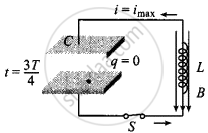Advertisements
Advertisements
Question
If a LC circuit is considered analogous to a harmonically oscillating spring block system, which energy of the LC circuit would be analogous to potential energy and which one analogous to kinetic energy?
Solution
When a charged capacitor C having an initial charge q0 is discharged through an inductance L, the charge and current in the circuit starts oscillating simple harmonically. If the resistance of the circuit is zero, no energy is dissipated as heat. We also assume an idealized situation in which energy is not radiated away from the circuit. The total energy associated with the circuit is constant.
The oscillation of the LC circuit is electromagnetic analogous to the mechanical oscillation of a block-spring system.
The total energy of the system remains conserved.
`1/2 CV^2 + 1/2 LI^2` = constant = `1/2 CV_0^2 = 1/2 LI^2`

At t = `(3T)/4`, capacitor again discharges completely i = imax

At `t = (T)/2`, block again reaches its mean position and its velocity becomes maximum
Comparison of oscillation of a mass-spring system and an LC circuit
| Mass spring system | v/s | LC circuit |
| Displacement `(x)` | Charge `(q)` | |
| Velocity `(v)` | Current `(i)` | |
| Acceleration `(a)` | Rate of change of current `((di)/(dt))` | |
| Mass `(m)` [Inertia] | Inductance `(L)` [Inertia of electricity] | |
| Momentum `(p = mv)` | Magnetic flux `(phi = Li)` | |
| Retarding force `(-m (dv)/(dt))` | Self induced emf `(-L (di)/(dt))` |
|
Equation of free oscillations: `(d^2x)/(dt^2) = - ω^2x`; where ω = `sqrt(K/m)` |
Equation of free oscillations: `(d^2q)/(dt^2) = - (1/(LC)).q`; where ω2 = `1/(LC)` |
|
| Force constant K | Capacitance C | |
| Kinetic energy = `1/2 mv^2` | Magnetic energy = `1/2 Li^2` | |
| Elastic potential energy = `1/2 Kx^2` | Electrical potential energy = `1/2 q^2/C` |
If we consider an L-C circuit analogous to a harmonically oscillating spring block system. The electrostatic energy `1/2 CV^2` is analogous to potential energy and energy associated with moving charges (current) that is magnetic energy `(1/2 LI^2)` is analogous to kinetic energy.
APPEARS IN
RELATED QUESTIONS
Calculate the quality factor of a series LCR circuit with L = 2.0 H, C = 2μF and R = 10 Ω. Mention the significance of quality factor in LCR circuit.
In a series LR circuit XL = R and power factor of the circuit is P1. When capacitor with capacitance C such that XL = XC is put in series, the power factor becomes P2. Calculate P1/P2.
Calculate the value of the capacity in picofarad, which will make 101.4 microhenry inductance to oscillate with a frequency of one megahertz.
A charged 10 microfarad capacitor is connected to an 81 mH inductor. What is the angular frequency of free oscillations of the circuit?
The oscillation in L.C. circuit is produced due to ____________.
The magnetic field energy in an inductor changes from maximum value to minimum value in 10 ms, when connected to an a.c. source. The frequency of the source is ______.
A charged 30 µF capacitor is connected to a 27 mH inductor. What is the angular frequency of free oscillations of the circuit?
The natural frequency (ca0) of oscillations in LC circuit is given by ______.
When an oscillator completes 100 oscillations its amplitude reduces to `1/3` of its initial value. What will be its amplitude, when it completes 200 oscillations?
When a charged condenser is allowed to discharge through the inductor the electrical oscillations are produced called ______
